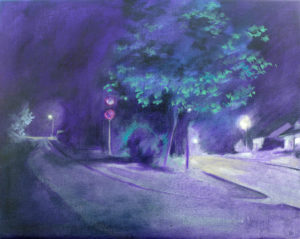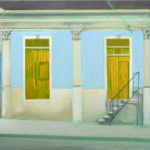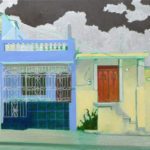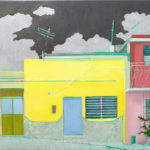
Vorstadtparadies, 80X110cm, 2013
Between the Individual and the Collective, the Periphery and the Center:
Chantal Maquet’s Architectural Portraits of Society
Identical apartment buildings, bordered by deserted sidewalks and flanked by power lines, sit in a row on a still street under a windswept, cloudy sky. Meager, low-growing vegetation indicates that the site has only recently been developed, and that the season might be sometime in early spring or late autumn. The time of day and the location, which could be everywhere and nowhere, are vague as well. The invisible inhabitants seem to be off to work or hidden in their dwellings. All is quiet in this lifeless settlement located between the city and the countryside. A solitary automobile is the only sign of life: the design of the car suggests that the essentially time- and placeless site was constructed in the mid-20th century and has thus long become historical. The painting Suburban Paradise (2013), which was included in Chantal Maquet’s Hamburg exhibition Les Belles Images in January 2014, marks the beginning of the artist’s aesthetic interest in (sub-)urban constructions: a thematic field that arose from her portraits of individuals and groups of people.
Proceeding from there, the painter, who was born in Luxembourg and lives in the German city of Hamburg, has continued her project (that initially revolved around female role clichés and their disruption) of critically exploring the social dynamics that underlie individual and collective behavior patterns. Her series of works dedicated to architecture, which have been evolving since 2014 parallel to her depiction of individuals and group constellations, are conjoined under the title Topos (in which the notions of “place”, “area”, and “building” resonate). While previously, as also in her work Suburban Paradise, Maquet primarily drew upon images found at flea markets or snapshots from her own family album as sources for her compositions, she meanwhile employs self-photographed documentation of personally experienced reality.

Utopie von Gestern 7, 80x100cm, 2014
In Suburban Paradise, the artist brings into focus a de-individualized, in a way generic form of life that takes shape in the non-descript frameworks of a frugal bedroom community idyll that appears to have been designed on the drawing board without much creative thought. One has encountered suburban (anti-)paradises of this type numerous times: they continue to present themselves in this or in similar manifestations. Titled Utopias of Yesterday, the first series of paintings of her Topos cycle is dedicated to post-war architecture in Hamburg, the conception of which — as elsewhere in war-ravaged Germany — drew upon innovative approaches of modernism under the auspices of progressive urban renewal. In this 10-part series (first shown in September 2014 on the occasion of the Open Monument Day in the auditorium of the Hamburg Deichtorhallen), Maquet does not merely reproduce the concrete constructions and brutalist high-rise facades of the architectural avant-garde of the 1950’s and 1960’s, which from today’s perspective often appear austere. She rather embarks on the search for the traces and remnants of yesterday’s utopias, which, if also for later generations almost imperceptibly so, are inscribed in the buildings.

Utopie von Gestern 1, 80x100cm, 2014
In bold colors and strong contrasts, she evokes their original, progressive potential for lending new form(s) to life and work in the city. Apart from office and high-rise complexes, the apartment blocks are depicted that have become characteristic of suburban settlements. Originally, these were planned with the objective to make modern, low-maintenance amenities and living in the countryside affordable for as many people as possible. Today, they stand for the monotony and lack of imagination of housing developments at the periphery, which, however, in the course of a general “de-urbanization” and a “polycentrically transformed regional spatial structure,”1 has long since begun rotating around its own suburban centers.
Lived Utopia: Breaking out of Repressed Freedom of Expression
A journey to Cuba in 2015 resulted in the 24-part work series Lived Utopia (2016) that presents an urban counter-concept to the collective housing projects of the suburbs. Here, individually molded facades now glow in colorful diversity before a gray, leaden backdrop. The latter alludes to the institutionalized conformity of Cuban society, which since decades has been regimented by a repressive one-party system. Maquet has recorded the buildings one by one, as when passing through a street, in the laconic style of the photographic representations of houses in Every Building on the Sunset Strip (1966) compiled by the American conceptual artist Edward Ruscha (*1937). In their rich diversity, the houses that are specified by their respective house numbers (in the series, only houses with even numbers are included), break out of the system-immanent politics of conformity dictated by the Cuban government.
- 908, 40x50cm, 2016
- 906, 40x50cm, 2016
- 904, 40x50cm, 2016
This series of paintings, which for the first time are based on photos taken by Maquet, depicts the facades of individual houses, whose neighboring houses are partially only perceivable in fragments, as well as heterogeneous rows of houses in vibrant hues of red, blue, and yellow. Stairways, projecting alcoves, and balconies alternate from house to house, as do the height and width of the buildings and the ornamental grids surrounding windows and verandas. People are rarely incorporated in the renditions: the individuality of their life concepts manifests itself implicitly in the aesthetic details of the architectural constructions. The artist largely features these during the period of repose at noon, when due to the immense heat the Cuban population prefers to remain indoors.2
The exterior view of the residences has been deliberately chosen by the artist and lends these a measure of abstraction that recall the typologies of the industrial buildings in the photographic series of Bernd und Hilla Becher (1931–2007; 1934–2015).3 Assembled almost exclusively in one place in Cuba, the views of the houses in a way represent a more general topographic style, which, as the artist observed on her travels through Cuba, in its variability in turn is indeed country-specific.4 In the collectively undertaken individual divergence, a societal liberation from state-sanctioned repression becomes manifest. Here, the “lived utopia” is not an expression of Cuba’s (failed) socialist project, but of an everyday resistance of the population which opposes the obliteration of the freedom of expression through the powers of imagination.
At Night (Outside the Door): Interplay of Light and Shadow in the Suburbs

Strooss 3, 40x50cm, 2017
In 2017, in the course of a guest residency at the castle of Bourglinster, a historical village in Luxembourg, Chantal Maquet approached the architectural manifestations of habitation in her own home country from the perspective of a stranger. Now addressing contemporary reality, she here once again returned to the theme of the “suburban paradise” of her earlier work that had been based on a photograph found at the flea market, and set out with her camera on a nocturnal research project to settlements in the municipality of Bourglinster, specifically to residential areas, where private homes lie secluded behind accurately trimmed hedges, low walls, and fences. The resultant 24-part series, Nuets (virun der Dier) [At Night (Outside the Door)], encompasses views of houses as well as of dimly lit rural streets, crossings, and bus stops, where no-one is to be seen waiting or wandering around. As sources for the most recent series of her Topos cycle, the painter used black-and-white photos, transposing the motifs into mysterious, intensely luminous scenes in iridescent colors on the canvas.

Strooss 2, 40x50cm, 2017
The bluish, violet and red tones radiating in the nocturnal darkness, and the interplay of light and shadow, gives the compositions an almost filmic quality and subtle tension. The lonely, rural roads sparingly illuminated by hazy lamplight that stretch into nowhere, or lose themselves around bends in blind spots, emphasize the peculiarly removed atmosphere of the dormant houses, whose inhabitants remain invisible as if absent or secluded in the depths of the buildings’ interiors. In their hermetic seclusion and reclusiveness, these appear like private bastions that seem to isolate themselves from all external influences: “In the scattered bungalow settlements, socially ghettoized environments of the white middle classes that have fled from the urban problems into the region develop, which have been purged of city problems. Here, once more, the traditional concept of the family as the heart of society is realized.”5
Yet even the light emanating from the windows is not definite proof of human presence: it could well be a ruse to protect an empty house against burglars. The glow of light might be deceptive, and the buildings, in turn, might only be empty shells signifying a profound absence of vital interaction. In the sense of Sigmund Freud, the “homely” (or familiar) tips over into the uncanny, while the void takes the place of substance, and the big sleep, the rigid stillness replaces vital existence and exchange.6 Maquet’s portraits of suburban order structures, which in their shrub-sheltered social exclusion suggest the opposite of the Utopias of Yesterday that was a rigid stillness intended for the collective and took form in apartment blocks outside of the metropolises, reveal a system: the model of individual dream fulfillment in the custom-made private home is a collective utopia that may be typified as a “suburban paradise” and that follows a social norm, albeit a more exclusive one.

Haus 5, 80x100cm, 2017
The artist undertook her field studies by car and in the company of her dog. And still she aroused suspicion when she photographed her observations in the dark for later rendition on the canvas. The aspect of mistrust that some inhabitants displayed towards her, becomes palpable in her paintings as well, which emanate the very ambiguity between the familiar and the uncanny that Freud has discussed as a reciprocal, intertwined dynamic.7 On the one hand, Maquet’s nocturnal (after-)images of peripheral, suburban life exude peacefulness and a poetic, contemplative atmosphere. Yet these also simultaneously appear like arenas of a vacuum that sets up props against the vital, organic chaos of life, excluding all that is disruptive and binding this into an ordering construct.
The artist’s pictorial language, however, counters factual representativeness: her compositions conflate the atmosphere of everyday-life experiences, which, beyond their direct references to Luxembourg, evoke the well-established western-European patterns of building and living, the mood of the surreal, nocturnal works of René Magritte (1898–1967), and the mysterious shadow effects conceived by Giorgio de Chirico (1888–1978) — both artists, who have inspired Maquet without having an immediate aesthetic impact.8 The fact that her visual explorations and documentations of the given spaces and places, which take shape in her Topos cycle, are simultaneously site-specific and extend beyond fixed localizations is therefore not a contradiction. The artist’s rather seeks to create an interplay between the places and eras, between the collective and the individual, and between individual and societal concepts.
In a large-format diptych, which Chantal Maquet also produced in 2017 in the course of her stipend, the village of Bourglinster spreads out before the eyes of the beholder below the elevated vantage point of a ledge in the woods, including the castle that is located to the left at eye level: a nocturnal panorama view that reveals a densely constructed village center unfolding behind opulent, turquoise vegetation. A glow surrounds the church, the houses, and the pathways. Here, everything is still snugly and closely intermeshed.
Together with the suburban houses that these belong to, the front gardens with their hedges and fences lie in the distance beyond the horizon. In her juxtaposition, the artist questions the life concepts that have defined our society through the ages, and continue to define it, which today in the shape of architectural “encasings, the packaging of human lives”8 are often posited as vehicles of isolation against integration and heterogeneous communities. Media theorist Paul Virilio has spoken of a “suburb of time that has been cleared of activities and where everyone is forced to retreat into a private life that actually resembles a loss of life.”9 Life knows no boundaries, no fences, and no demarcation lines. It takes place where visionary ideas take shape. These are harbored in equal measure in buildings and in their disruptions. In her paintings, Chantal Maquet allows both to persist in her works: the constructed utopia of a community, which seeks its happiness collectively, and the utopias of individual happiness that must still be conceived. She thus spans an arc between the times and the places, the buildings, and the visions connected with these for making oneself at home in the world in the future.
Belinda Grace Gardner
1. Cf. Walter Prigge: Metropolitisierung. Zum Strukturwandel der europäischen Stadt, in: Gereon Sievernich; Thomas Medicus (eds.): Zivilisation. Städte – Bürger – Cybercities. Die Zukunft unserer Lebenswelten, Vol. 4 of the exhib. cat. publ. in conjunction with 7 hügel – Bilder und Zeichen des 21. Jahrhunderts (Martin Gropius Bau, Berlin: 2000), Berliner Festspiele (ed.), Berlin 2000, p. 36.
2. In a phone conversation with the author on November 21, 2017, Chantal Maquet outlined that she specifically took the photographic images that served as sources for her house series in Cuba at noon, a time when hardly any residents were outside on the street.
3. On the one hand, the photographic series following a consistent system produced by Bernd and Hilla Becher, encompassing among other constructions smelting furnaces and gas tanks, shaft, water, and cooling towers, document historical industrial architecture, and thus a time that has passed. Yet, on the other hand, they also lend the anonymous facades a face, rendering these differentiated portraits of social change at the same time.
4.Chantal Maquet in a telephone conversation with the author on November 21, 2017.
5. Prigge, in: Sievernich; Medicus 2000, p. 36.
6. Cf. on the ambiguity of the familiar and its proximity to the uncanny: Sigmund Freud: Das Unheimliche (1919) / “The Uncanny” [1919], in: The Complete Psychological Works, Vol. XVII, London, 1955, pp. 217-56 [transl. by Alix Strachey, in S. Freud, Complete Works, 1925, 4, pp. 368-407]: http://www.ricorso.net/rx/library/criticism/guest/Freud_S/Freud_S2.htm (accessed Dec. 7, 2017).
7. Cf. ibid.
8. Chantal Maquet in a telephone conversation with the author on November 21, 2017.
9. Paul Virilio: Die Auflösung des Stadtbildes, in: Jörg Dünne; Stephan Günzel (eds.): Raumtheorie. Grundlagentexte aus Philosophie und Kulturwissenschaften, Frankfurt / Main 2006, p. 265.
[All of the quotes have been translated into the English by the author.]


